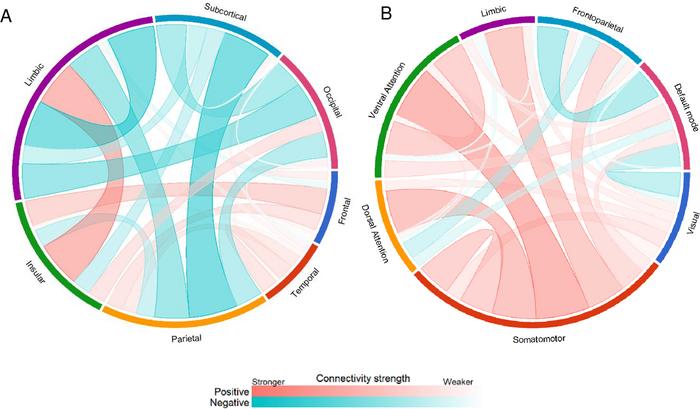As we traverse the journey of life, subtle yet profound changes occur within the intricate networks of our brain. Recent breakthroughs in neuroscience have illuminated a compelling link between aging and alterations in intrinsic functional connectivity, specifically within brain networks that govern sociability. A study published in PLOS One reveals how aging reshapes communication patterns among key brain regions, potentially underpinning the decline in social engagement frequently observed in older adults. The research conducted by a team based in Singapore offers a detailed mapping of these connectivity changes using advanced neuroimaging techniques, shedding light on the neural substrates that influence our evolving social behaviors across the lifespan.
Intrinsic functional connectivity refers to the synchronized fluctuations in brain activity that occur across distinct regions during rest. These spontaneous interactions form coherent networks that reflect the brain’s functional architecture. Among these, certain networks are critically involved in social cognition, emotional processing, and interpersonal interaction. The study harnessed resting-state functional magnetic resonance imaging (rs-fMRI) data from a broad cohort of adults spanning a wide age range to investigate how these networks adapt as the brain ages. By examining changes in resting-state functional connectivity (rsFC), the authors sought to uncover neural signatures that mediate the relationship between age and sociability.
To precisely localize and characterize connectivity variations, the researchers employed the Brainnetome Atlas, a fine-grained parcellation scheme, and Yeo’s 7-network parcellation to contextualize findings within well-established large-scale brain networks. This dual approach enabled a multifaceted analysis, revealing age-related reductions and reorganizations of connectivity both within localized regions and across distributed networks. Of particular note was the observation that the default mode network (DMN) and salience network exhibited marked connectivity declines correlated with diminished social engagement.
These networks play pivotal roles in self-referential thought, social cognition, and detecting behaviorally relevant stimuli, all of which are fundamental to maintaining social bonds. The deteriorations in their intrinsic connectivity patterns likely contribute to an impaired ability to initiate and sustain social interactions. By applying network-based statistics (NBS) and regression analyses, the study meticulously quantified how the strength of specific interregional connections diminishes with advancing age, paralleling decreases in sociability as reported by behavioral assessments.
One of the study’s groundbreaking insights lies in its mediation analysis, which demonstrated that altered brain connectivity serves as a neural pathway through which age impacts social functioning. In other words, connectivity disruptions are not merely correlates but mechanistic mediators of sociability decline. This finding reframes our understanding of aging’s effect on social behavior, emphasizing the importance of preserving intrinsic brain networks to combat social withdrawal and isolation, which are prevalent issues linked with numerous adverse health outcomes.
The implications of this research extend beyond theoretical neuroscience, bearing relevance for clinical neuropsychology and geriatric psychiatry. Social isolation and decreased sociability in older adults have been connected to heightened risks of depression, cognitive decline, and even mortality. Understanding the neural basis of these changes equips clinicians and researchers with potential biomarkers for early detection and intervention. Future strategies might include targeted neurostimulation, cognitive training, or lifestyle interventions designed to enhance or preserve functional connectivity within these critical networks.
Moreover, the study sets a precedent for leveraging large-scale neuroimaging datasets coupled with sophisticated analytical methods to decode complex brain-behavior relationships. The use of multi-atlas brain parcellation and rigorous statistical thresholding enhances the robustness and reproducibility of findings, addressing long-standing challenges in neuroimaging research related to variability and methodological inconsistencies.
Nonetheless, while the cross-sectional nature of the data provides valuable snapshots of age-related connectivity alterations, longitudinal studies are warranted to map individual trajectories of neural change over time. Such longitudinal research would elucidate causality and the temporal dynamics between brain network integrity and sociability, potentially uncovering critical periods for intervention. Additionally, integrating multimodal imaging and molecular data could deepen mechanistic insights by linking functional connectivity changes to underlying cellular and neurochemical aging processes.
The study’s authors report no specific funding for this work, underscoring the scientific community’s growing commitment to advancing open-access research on brain aging. The article’s findings are openly accessible under the CC-BY 4.0 license, encouraging widespread dissemination and scholarly engagement. This transparency fosters collaborative efforts aimed at mitigating the social consequences of aging through neuroscientific innovation.
In conclusion, the intricate dance of brain networks dynamically evolves with age, influencing how we relate to others throughout our lives. The demonstrated mediation of age effects on sociability by intrinsic functional connectivity highlights the brain’s central role in shaping social experiences. As science continues to unravel the complexities of brain aging, such insights pave the way for developing novel approaches to promote social vitality and cognitive health in the aging population, ultimately enriching quality of life and societal cohesion.
Subject of Research: Brain functional connectivity and its impact on social behavior across aging.
Article Title: Intrinsic functional connectivity brain networks mediate effect of age on sociability.
News Publication Date: 28-May-2025.
Web References: http://dx.doi.org/10.1371/journal.pone.0324277
Image Credits: Dan et al., 2025, PLOS One, CC-BY 4.0.
Keywords: brain aging, intrinsic functional connectivity, resting-state fMRI, social cognition, default mode network, salience network, brainnetome atlas, Yeo’s networks, sociability, neuroimaging, network-based statistics, aging and social behavior.




